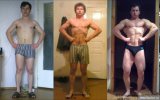HST_Rihad
Active Member
(Just an opinion, please read it as such)
SD, along with lowering muscle protection from the current loads, also causes muscle atrophy (prooflink). Then, when training is resumed later, the "unparalleled growth" is nothing more than quick regaining of the muscle lost thanks to the "muscle memory" phenomenon. Point is, unless you reach and try to surpass the loads you finished the previous cycle with in the first place, you're never gonna get bigger (muscularly, not as a result of chronic overfeeding) than you were. It takes you about 1-2 weeks of SD to lose some of what you've gained, and 4 more weeks to regain most of it, 5-6 weeks of staying the same just before you begin to lift heavier than you did before. But CNS can be recovered much quicker, so what's the point in staying the same?
Not meaning to disrespect HST or anything, I'm still following it, but this is what may happen if the principles are followed to a T.

The guy above hasn't heard of HST. Quite a spectacular change in looks, don't you think? 100% natural. He followed Stuart McRobert's training principles for a few months with no results, that's him on the left. Then he switched to high volume training, a split routine 6 days per week, hitting every muscle twice per week. That's him in the middle after 8 months, and on the right after 4 years. And by higher volume I mean very high volume, especially for the lats. Forget about the "scientifically proven" 30-60 reps per MG. Here's an example of his lat workout done twice per week (loads in kilos):
bent over rows 5х8-80/82,5/85/85
reverse grip bent over rows 5х10-80
DB bent over row 5х(8+8)-46/48,5/51/51
pull-ups 5х10-BW 70
pull-overs 5х10-30
wide grip pull on a 3D 5х8-65/67,5/70/70
wide grip pull EZ-bar head supported 5х10-50/52,5/55/55
bent over delt raises 5х10-14,25+14,25/14,25+14,25/15,5+15,5/15,5+15,5
bicep curls 5х10-30
each set performed every 1.5-2 minutes (which included the time to do the set).
SD, along with lowering muscle protection from the current loads, also causes muscle atrophy (prooflink). Then, when training is resumed later, the "unparalleled growth" is nothing more than quick regaining of the muscle lost thanks to the "muscle memory" phenomenon. Point is, unless you reach and try to surpass the loads you finished the previous cycle with in the first place, you're never gonna get bigger (muscularly, not as a result of chronic overfeeding) than you were. It takes you about 1-2 weeks of SD to lose some of what you've gained, and 4 more weeks to regain most of it, 5-6 weeks of staying the same just before you begin to lift heavier than you did before. But CNS can be recovered much quicker, so what's the point in staying the same?
Not meaning to disrespect HST or anything, I'm still following it, but this is what may happen if the principles are followed to a T.

The guy above hasn't heard of HST. Quite a spectacular change in looks, don't you think? 100% natural. He followed Stuart McRobert's training principles for a few months with no results, that's him on the left. Then he switched to high volume training, a split routine 6 days per week, hitting every muscle twice per week. That's him in the middle after 8 months, and on the right after 4 years. And by higher volume I mean very high volume, especially for the lats. Forget about the "scientifically proven" 30-60 reps per MG. Here's an example of his lat workout done twice per week (loads in kilos):
bent over rows 5х8-80/82,5/85/85
reverse grip bent over rows 5х10-80
DB bent over row 5х(8+8)-46/48,5/51/51
pull-ups 5х10-BW 70
pull-overs 5х10-30
wide grip pull on a 3D 5х8-65/67,5/70/70
wide grip pull EZ-bar head supported 5х10-50/52,5/55/55
bent over delt raises 5х10-14,25+14,25/14,25+14,25/15,5+15,5/15,5+15,5
bicep curls 5х10-30
each set performed every 1.5-2 minutes (which included the time to do the set).
